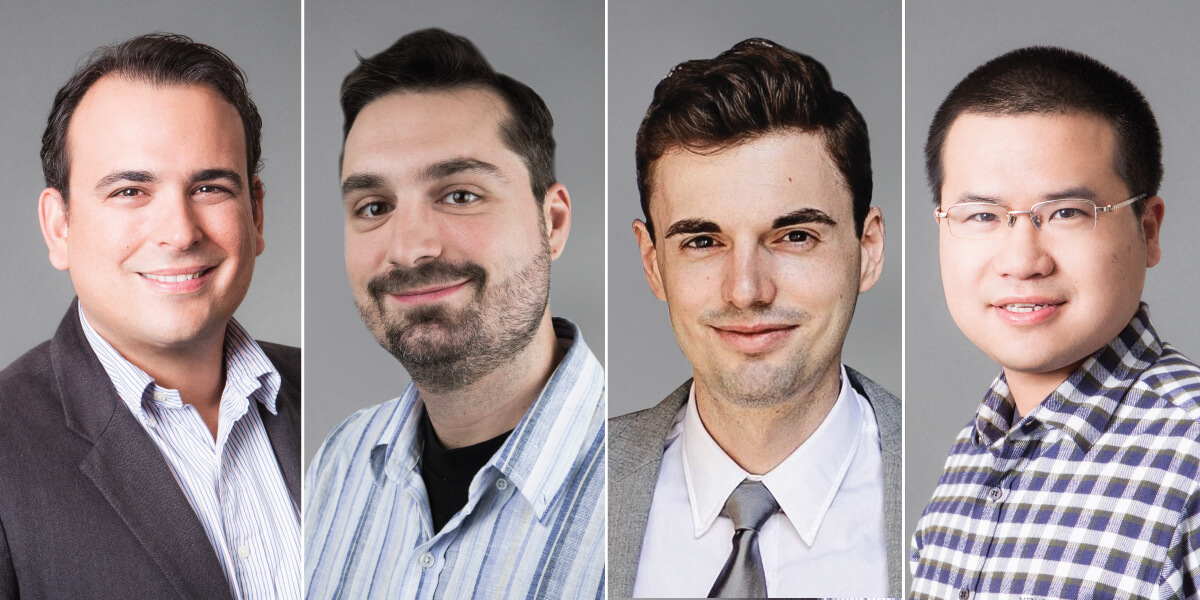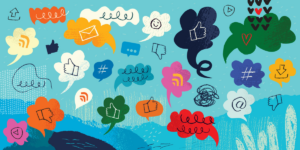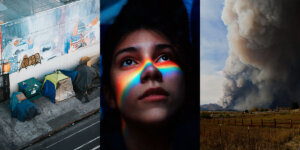
From left: Felipe de Barros, Ilias Diakonikolas, Wyatt Lloyd and Han Wang, winners of 2017 NSF CAREER Awards. Photo/USC Viterbi
Four USC Viterbi professors received the prestigious National Science Foundation CAREER award in 2017. Recipients of the award are early-career faculty members whose outstanding integration of research and education poises them for ongoing leadership in their respective fields.
This year’s winners are Felipe de Barros, an assistant professor in the Sonny Astani Department of Civil and Environmental Engineering and a leading expert on stochastic hydrogeology; Ilias Diakonikolas, an assistant professor and Andrew and Erna Viterbi Early Career Chair in USC Viterbi’s Department of Computer Science; Wyatt Lloyd, an assistant professor in the Department of Computer Science; and Han Wang, an assistant professor in the Ming Hsieh Department of Electrical Engineering.
Felipe de Barros
“Considering the quality of Felipe’s work, I had no doubt he was going to receive the CAREER award,” said Lucio Soibelman, Astani Department chair. “Very few people are capable of creating reliable models from such a complex system. Felipe is one of them.”
De Barros’ research aims to model subsurface water flow to better understand how chemicals travel through soil. He compares an aquifer to a network of mismatched sponges.
“Imagine you go all over L.A. and collect a hundred different sponges, different brands, different materials, and assemble them all together,” de Barros said.
Like the system of sponges, the aquifer’s hydrogeological properties vary throughout space. Without a clear view of the subsurface environment, de Barros must use mathematical models to approximate how far and fast water and contaminants will travel.
Understanding and mapping subsurface flow patterns has widespread implications for public health, environmental science and beyond. In the event of a petroleum leak at a gas station, for instance, de Barros’ work can help predict when contaminants will reach the water table, what direction they will travel and potential long-term impacts of the leak.
A native of Rio de Janeiro, Brazil, de Barros completed his Ph.D. in civil and environmental engineering at UC Berkeley in 2009 under the mentorship of Yoram Rubin. He studied the impact of data acquisition on hydrogeological model predictions.
De Barros won a grant of approximately $500,000, which he will use to fund student research, as well as STEM programs in local schools. He named Professor Amy Childress, Professor Patrick Lynett, and Soibelman, the department chair, as influential USC mentors.
Soibelman sees a bright future for de Barros.
“He is part of the new generation deciding the strategy, the vision, the direction of the department and the field,” Soibelman said.
De Barros, who was artistically inclined from a young age, said his father’s work as an engineer inspired him to pivot toward a scientific discipline. When his father explained the history and philosophy behind his mathematical models, “that’s when I saw the field of engineering was not just a dry field,” said de Barros. “There’s so much art, so much poetry in developing models to capture features of the real world.”
The beauty and intrigue of his work, the support of his fellow colleagues and the daily opportunities to mentor graduate students are what de Barros credits with helping him win the NSF CAREER Award.
“Every day I come to work in this place, I come with a smile, and I leave with a smile,” he said.
Ilias Diakonikolas
“It’s entirely well-deserved,” said Gaurav Sukhatme, chair of the USC Viterbi Department of Computer Science, of Diakonikolas, a leading expert in algorithmic machine learning. “Ilias has been doing some amazing work. I’m very happy for him.”
Diakonikolas creates algorithms that make machine-learning both more efficient and more robust. Efficiency means that algorithms can operate in high-dimensional learning environments, when hundreds or thousands of variables are in use. In such situations, there are often outliers, or inputs that a mathematical model cannot accurately represent. Diakonikolas aims to design algorithms that can handle these tricky cases and are thus more robust.
A related strand of Diakonikolas’ work is on algorithmic aspects of statistics. An important goal in many scenarios is to decide when a model can be relied upon. Diakonikolas’ work in inferential algorithms helps in making fast and accurate predictions, even in the presence of minimal amounts of data.
Rather than working on a specific collection of data, Diakonikolas takes a broader view. “My goal is to develop general methods that work for broad families of data sets, so they can be applied in many different practical settings,” he said.
Indeed, the applications for his research are extremely diverse, spanning areas such as voice recognition or driverless cars.
“You’d be hard-pressed to find an algorithm that doesn’t deal with special cases,” said Sukhatme, the department chair.
With the $540,000 NSF grant, Diakonikolas plans to continue his development of new algorithmic techniques to solve fundamental problems in learning and testing probabilistic models.
A native of Greece, he completed his undergraduate degree at the National Technical University of Athens before coming to the United States. Under the guidance of Professor Mihalis Yannakakis, Diakonikolas earned his Ph.D. in computer science from Columbia University.
He then completed two years of post-doctorate work at UC Berkeley, where he was a Simons Postdoctoral Fellow in theoretical computer science. He later served on the faculty at the University of Edinburgh before coming to USC.
Diakonikolas is an active member of the USC community, helping run the CS Theory Group, a leader in theoretical computer science, as well as the Machine Learning Center, which connects students with faculty mentors.
He is also organizing a session at the Information Theory and Applications Workshop in San Diego this month, as well as two workshops later this year. One will focus on robust, high-dimensional information and the other on testing high-dimensional models.
“Ilias has his own unique mix of both creating machine learning algorithms, and also studying the underlying mathematics of machine learning,” Sukhatme said. “By teaching two new graduate courses in these areas, he represents a primary focus of USC. Our faculty do cutting-edge research in the field and then immediately bring this into the classroom.”
Diakonikolas joined the USC faculty in 2016.
Wyatt Lloyd
Lloyd received a grant of $590,000 to fund his ongoing research on distributed data stores.
“I’m thrilled that Wyatt has won the NSF CAREER award,” said Gaurav Sukhatme, chair of the Department of Computer Science. “His research aims to develop next generation scalable storage systems and a scientific foundation for their design…it is thus both intellectually compelling and practically useful.”
Large web services such as Facebook and Amazon need to store massive amounts of data and perform billions of computations every day. To do so, they rely on a network of many computers working in tandem.
“When you have a huge number of computers, it’s notoriously challenging to program them and to ensure they are interacting properly,” Lloyd said.
For example, it’s inevitable that at least one computer will be crashing at any given time. And with multiple computers processing a single request, there doesn’t exist a total order over the operations. In other words, it’s possible for computations to occur out of order. To address this, networks of computers process and store data systematically across many machines.
Lloyd studies the trade-off between performance and guarantees in an effort to design better distributed data stores. To maximize performance, he looks at two factors: latency and throughput. Latency refers to the time that elapses between a query and a response, for example, how long it takes for a new status to post to Facebook. Throughput is how many operations a machine can perform each second. Lloyd wants the lowest latency and the highest throughput possible, so that a network of computers can operate with maximum efficiency.
But he must balance performance with guarantees, which makes a group of computers act like a single machine. His team develops impossibility results that prove some designs are not possible. Then they build systems that are the best possible, in that they go right up to the edge of the impossibility results, to push the boundaries of current technology.
Lloyd’s work is generally applicable to large web services: anything from Google to Twitter to Healthcare.gov.
“Any situation where there’s a huge amount of data and people are interacting regularly poses a difficult computer science problem,” he said. “Facebook is one particularly compelling and tricky example, because they operate on such a huge scale.”
This knack for problem-solving is what initially drew Lloyd to computer science.
“I really like solving puzzles, and I think a lot of computer science is figuring out how to solve really interesting, hard puzzles,” said Lloyd.
In 2013, Lloyd completed his Ph.D. at Princeton in the SNS (Network Systems) lab, where he worked with his advisor Michael J. Freedman on geo-replicated storage. He then spent one year at Facebook as a postdoctoral researcher, working on the systems that store and deliver photos and videos across the platform. Lloyd joined the USC faculty as an assistant professor in 2014.
He now co-operates USC’s Networked Systems Lab with two other professors. The lab provides an opportunity for students to work collaboratively and to receive counsel from experts across the spectrum of data systems, from mobile to internet routing to data center networking.
“My experience here has been fantastic,” Lloyd said . “I have a ton of fun working on hard, interesting problems. And I have really smart, enthusiastic colleagues and students that I get to tackle these problems with.”
Han Wang
“Han is a leader in our research program, so I was very happy to hear that he received the award. It was not a surprise at all,” said Eun Sok Kim, the Electrophysics chair of the Ming Hsieh Department of Electrical Engineering.
Wang’s research explores emerging materials that can be used in the invention of new electronic and photonic devices. His most recent work aims to develop the fundamentals of electronic technologies based on an emerging semiconductor material called black phosphorous. A layered two-dimensional material, black phosphorous has unique electronic properties, which can be explored to develop devices with new functionalities and better performance, including creating thin-film electronic devices that can operate at very low power. Black phosphorous can also be used to build adaptive electronic devices that can be reconfigured to perform multiple different functions.
This research on new materials and devices has potential applications for many fields of electronics technology, including computation, memory storage and communications, for both civilian and military purposes. Wang said other target applications for black phosphorous include night-vision and thermal imaging devices. Such devices detect light at infrared wavelengths, for which black phosphorus is best-suited.
“I really like working in the field of new materials and new devices because it’s a highly multidisciplinary field,” Wang said. “It allows me to work with researchers from electrical engineering, physics, materials science and chemistry—and when people with different expertise come together, exciting things can happen.”
Born in China, Wang attended high school in Singapore and received his B.A. and M.Eng degrees in electrical and informational science from Cambridge University.
“I was always inclined to study science and engineering, but after finishing my undergraduate degree, I became more attracted to hardware-based technology. I realized I liked to build things,” he said.
Wang earned his Ph.D. from the Massachusetts Institute of Technology, where he studied two-dimensional materials. He spent one year with the Nanoscale Science and Technology group at IBM T.J. Watson Research Center before joining the USC faculty in August 2014.
At USC, Wang enjoys working with other leading researchers in the field of nanoscience and semiconductor technology.
“Faculty members are proud to have him in the department, not only to collaborate with him, but also because his research is very highly regarded. It makes our department more reputable in the academic community,” said Kim, the department chair.
He says being based in L.A. provides a further benefit: he can collaborate with the local industry.
“This cooperation helps bridge the gap between the fundamental science and practical engineering technologies,” Wang said.
With the $500,000 he received from NSF, Wang will continue his research on black phosphorous. His current project also provides research opportunities for both undergraduates and high school students.
“New materials hold great promise for future technologies,” he said. “Of course there will be lots of challenges, but today’s emerging materials and new device concepts carry the hope for tomorrow’s technological breakthroughs.”
Save
Save
Published on March 27th, 2017
Last updated on May 16th, 2024













